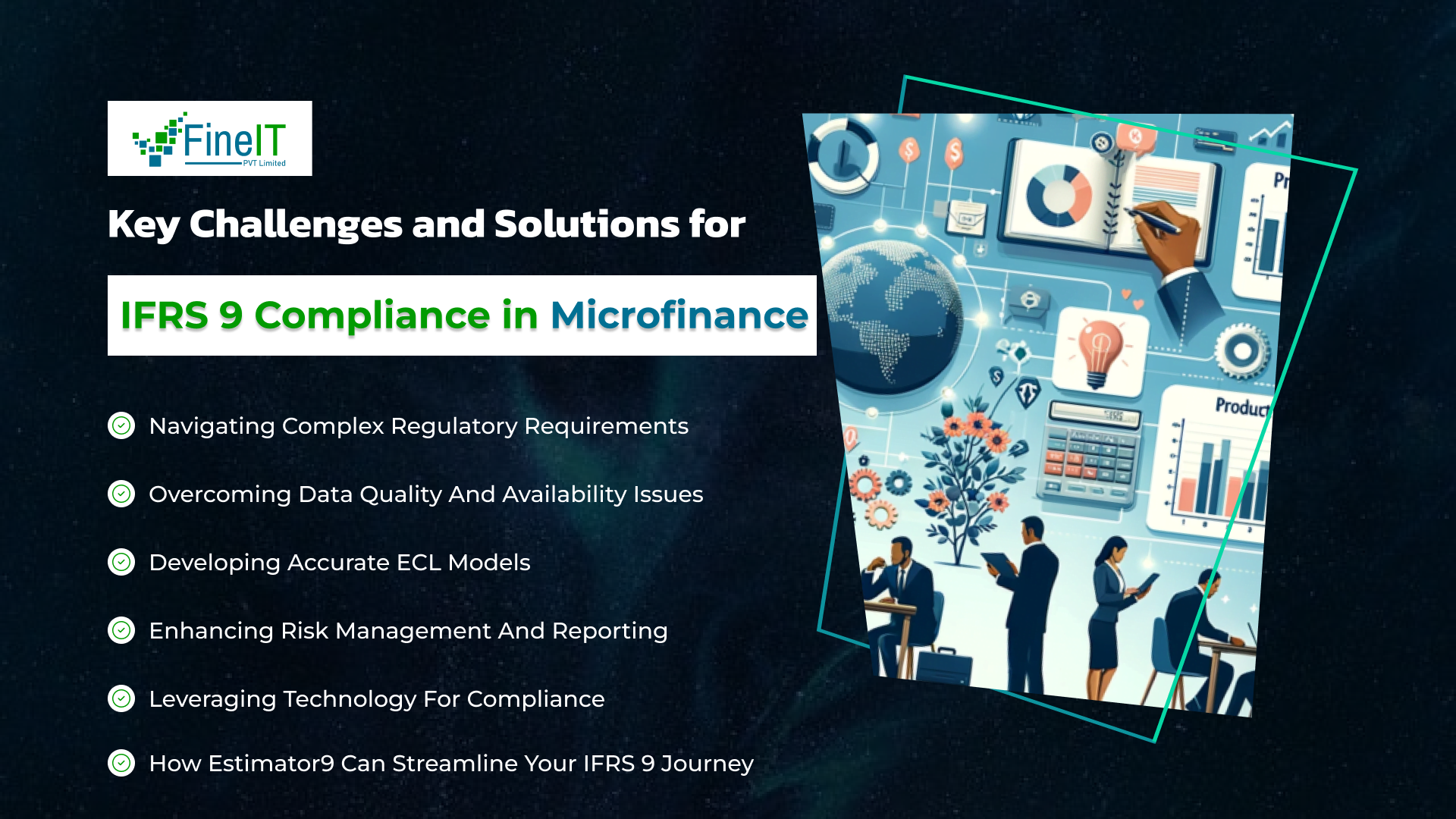The introduction of the International Financial Reporting Standard 9 (IFRS 9) marked a significant shift in the financial reporting landscape for all financial institutions, including Microfinance Institutions (MFIs) and Microfinance Banks (MFBs). IFRS 9, which focuses on the classification, measurement, and impairment of financial instruments, aims to enhance transparency and accuracy in financial reporting. However, for MFIs, particularly those operating in emerging markets, this transition poses unique challenges and opportunities. This article explores the impact of IFRS 9 on MFIs, highlighting the main challenges, strategies to overcome them, and the potential benefits of compliance.
1. Understanding IFRS 9 and Its Relevance to Microfinance
IFRS 9 replaces the previous IAS 39 standard, introducing a forward-looking approach to recognizing Expected Credit Losses (ECL). For MFIs, this change is significant as it requires institutions to assess the risk of default more proactively, even before any credit deterioration occurs. Key aspects of IFRS 9 that affect MFIs include:
Classification and Measurement
Financial assets are classified based on the business model and contractual cash flow characteristics. For MFIs, this affects how loans and other financial instruments are reported.
Impairment (ECL Model)
The ECL approach requires MFIs to calculate potential losses on loans from the day they are originated. This differs from the incurred loss model, which only recognized losses after they occurred.
Hedge Accounting
Although less relevant for many MFIs, those engaging in complex financial products must adhere to stricter guidelines under IFRS 9.
2. Key Challenges Faced by Microfinance Institutions
a. Data Collection and Management
One of the main hurdles MFIs face under IFRS 9 is the need for comprehensive and high-quality data. IFRS 9 requires detailed historical data, including borrower behavior, macroeconomic indicators, and forward-looking information, to assess the probability of default.
Data Scarcity
Many MFIs lack robust data management systems, making it difficult to gather and analyze the data needed for ECL calculations.
High Costs
Implementing data collection and management systems can be costly, especially for smaller MFIs with limited resources.
Technical Expertise
There is often a lack of in-house expertise to analyze complex data requirements, necessitating the hiring of external consultants, which further increases costs.
b. Model Development and Validation
The development of ECL models is complex, requiring sophisticated statistical techniques and modeling skills. Many MFIs are unfamiliar with advanced credit risk modeling, making it difficult to comply with IFRS 9.
Lack of Expertise
Developing ECL models requires skills that are often beyond the existing capabilities of many MFIs.
Validation Challenges
Even after developing an ECL model, MFIs face the challenge of validating these models to ensure they are accurate and reliable.
c. Regulatory and Compliance Costs
Compliance with IFRS 9 comes with increased regulatory scrutiny. MFIs must ensure their models and calculations meet regulatory standards, which often necessitates frequent audits and validations.
Increased Audit Requirements
The ECL approach requires regular updates and validations, adding to the operational burden.
Resource Allocation
MFIs need to allocate resources to ensure ongoing compliance, which can divert funds from core activities like lending and outreach.
d. Impact on Financial Performance and Capital Requirements
The shift to a forward-looking ECL model can lead to increased loan loss provisions, affecting the profitability and capital adequacy of MFIs. This can be particularly challenging for MFIs operating on thin margins.
Higher Provisions
The need to recognize potential losses early can significantly increase loan loss provisions, affecting the overall financial health of MFIs.
Capital Constraints
Increased provisions can also impact capital requirements, making it harder for MFIs to meet regulatory capital standards.
3. Opportunities Presented by IFRS 9
Despite the challenges, IFRS 9 also presents several opportunities for MFIs, particularly in improving risk management and enhancing stakeholder confidence.
a. Enhanced Risk Management
The forward-looking approach of IFRS 9 encourages MFIs to adopt better risk management practices. By identifying potential risks early, MFIs can take proactive steps to mitigate losses.
Better Credit Assessment
Improved data collection and analysis help MFIs make more informed lending decisions, reducing the risk of defaults.
Early Intervention
Identifying at-risk loans early allows MFIs to engage with borrowers proactively, offering restructuring or other support to avoid default.
b. Increased Transparency and Stakeholder Confidence
Compliance with IFRS 9 demonstrates an MFI’s commitment to global standards of financial reporting, which can enhance its reputation and attract investment.
Investor Confidence
Transparent reporting can attract impact investors and donors who value accountability and robust financial management.
Regulatory Alignment
Compliance with IFRS 9 helps align MFIs with broader regulatory frameworks, facilitating better relations with regulators and policymakers.
c. Competitive Advantage
MFIs that successfully implement IFRS 9 software solution can differentiate themselves from competitors. By demonstrating advanced risk management and compliance capabilities, these institutions can attract more clients and funding.
- Enhanced Product Offering: Improved risk assessments can lead to better-tailored financial products, meeting the specific needs of clients and enhancing market position.
4. Strategies for Successful Implementation
a. Leveraging Technology
Investing in technology can significantly ease the burden of compliance. MFIs should explore affordable solutions that automate data collection, ECL calculations, and reporting.
Cloud-Based Solutions
Cloud technology can offer scalable and cost-effective options for smaller MFIs to manage data and perform complex calculations.
Third-Party Tools
Using third-party ECL modeling tools can reduce the need for in-house expertise and ensure accurate compliance.
b. Capacity Building and Training
Investing in staff training and development is crucial. MFIs should prioritize building internal capacity to understand and implement IFRS 9 requirements.
Workshops and Training Programs
Collaborating with consultants or industry bodies to conduct training sessions can enhance in-house capabilities.
Knowledge Sharing
Engaging with peer institutions to share best practices and learn from others can accelerate the learning curve.
c. Strategic Partnerships
Forming partnerships with financial technology firms, consultants, or other institutions can provide the expertise and support MFIs need to comply with IFRS 9 without bearing the full cost in-house.
Collaborative Models
Partnering with local banks or other MFIs for shared resources and expertise can reduce implementation costs.
Advisory Support
Engaging with advisory firms specializing in IFRS 9 can provide valuable guidance on compliance strategies.
Conclusion:
The implementation of IFRS 9 poses significant challenges for Microfinance Institutions (MFIs) and Microfinance Banks (MFBs), particularly in areas such as data management, model development, and regulatory compliance. However, these challenges also present unique opportunities for improving risk management, enhancing transparency, and building stakeholder confidence. By investing in technology, training, and strategic partnerships, MFIs can not only meet compliance requirements but also position themselves as leaders in financial inclusion. The path to compliance may be demanding, but the benefits of better risk management and increased investor confidence make the effort worthwhile.
How Estimator9 Can Help MFIs and MFBs
It is Fine IT’s fully automated IFRS 9 software solution specifically designed to address the unique needs of MFIs and MFBs. With a focus on efficiency and compliance, Estimator9 simplifies the complex process of Expected Credit Loss (ECL) calculations, helping institutions meet IFRS 9 standards seamlessly. Here’s how Estimator9 can make a difference:
Automated ECL Calculations
It automates the entire ECL calculation process, reducing the risk of errors associated with manual Excel-based models. This ensures accuracy and consistency in reporting, helping MFIs achieve compliance effortlessly.
Advanced Data Integration
The software is equipped to handle diverse data sources, integrating historical data, macroeconomic indicators, and forward-looking information to provide a comprehensive view of credit risk.
Regulatory Compliance
It is built with compliance in mind, ensuring that MFIs and MFBs meet all IFRS 9 requirements. The software is regularly updated to reflect changes in regulations, keeping institutions aligned with the latest standards.
User-Friendly Interface
Designed for ease of use, intuitive interface allows users to manage data, run calculations, and generate reports without needing extensive technical expertise.
Enhanced Risk Management
By providing real-time insights into credit risk, Estimator9 enables institutions to proactively manage their portfolios, engage borrowers early, and reduce the likelihood of defaults.
Scalable and Cost-Effective
Estimator9’s scalable architecture makes it suitable for MFIs of all sizes, offering a cost-effective solution that grows with your institution.
Support and Expertise
Backed by a team of financial and technical experts, Estimator9 offers ongoing support to help institutions navigate the complexities of IFRS 9, from initial setup to continuous updates and training.
Unlock the potential of your MFI with Estimator9, and transform your approach to IFRS 9 compliance. With our advanced software, you can focus on what matters most empowering communities through financial inclusion while staying compliant with global standards.
#IFRS9 #Microfinance #Estimator9 #ECLCalculation #FinancialInclusion #RiskManagement #ComplianceSolutions



